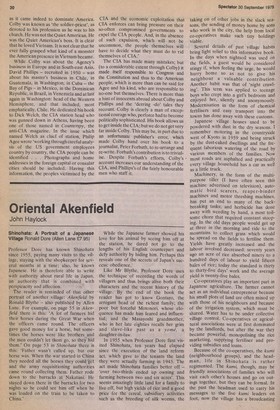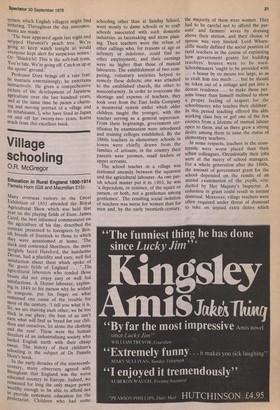Oriental Akenfield
John Haylock
Shinohata: A Portrait of a Japanese Village Ronald Dore (Allen Lane £7.95) Professor Dore has known Shinohata since 1955, paying many visits to the village, staying with the shopkeeper for several months at a time; also, he knows Japanese. He is therefore able to write with authority about rural life in Japan, an authority that is combined with perspicacity and affection.
the reader is reminded of that other portrait of another village: Akenfield by Ronald Blythe — also published by Allen Lane. For example, on page 55 in A kenfield there is this: 'A lot of farmers hid their horses -during the Great War when the officers came round. The officers gave good money for a horse, but sometimes the horses were like brothers and the men couldn't let them go, so they hid them.' On page 53 in Shinohata there is this: 'Father wasn't called up, but our horse was. When the war started in China they needed all the horses they could get and the army requisitioning authorities came round collecting them. Father rode down to the barracks at Nakatani. He stayed down there in the barracks for two nights so he could see him off when he was loaded on the train to be taken to China.' While the Japanese farmer showed his love for his animal by seeing him off at the station, he dared not go to the lengths of his English counterpart and defy authority by hiding him. Perhaps this reveals one of the secrets of Japan's success: obedience.
Like Mr Blythe, Professor Dore uses the technique of recording the words of villagers and thus brings alive both their characters and the recent history of the village. By the end of the book the reader has got to know Gontaro, the arrogant head of the richest family; the poor but forceful Motonori, whose eloquence has made him feared and influential; and the Masayoshi grandmother, who in her late eighties recalls her grim and slave-like past as a yome, daughter-in-law.
In 1955 when Professor Dore first visited Shinohata, ten years had elapsed since the execution of the land reform act, which gave to the tenants the land they were actually farming in 1945. The act made Shinohata families better off — 'over two-thirds ended up owning and farming between two and six acres'. This seems amazingly little land for a family to live off, but high yields of rice and a good price for the cereal, subsidiary activities such as the breeding of silk worms, the taking on of other jobs in the slack seasons, the sending of money home by sons who work in the city, the help from local co-operatives make such tiny holdings viable.
Several details of past village habits bring light relief to this informative book. In the days when nightsoil was used on the fields, a guest would be considered stingy if, when feeling the urge, he would shturgryy home so as not to give his neighbour a valuable contribution. Another habit was that of 'night crawling'. This term was applied to teenage boys who crept into a girl's bedroom and en) her, silently and anonymously. Moodyeed rnisation in the form of chemical fertilisers and easy transport into the towns has done away with these customs.
Japanese village houses used to be powdered with dust in the dry seasons. I remember motoring in the countryside west of Kyoto in 1959 and being struck by the dust-caked dwellings and the frequent laborious watering of the road by various members of the families. Now most roads are asphalted and practically every village household has a car as well as a little truck.
Machinery, in the form of the multipurpose tiller (I have often seen this machine advertised on television), automatic bird scarers, reaper-binder machines and motor threshing machines, has put an end to many of the backbreaking tasks; and herbicide has done away with weeding by hand, a most toilsome chore that required constant stooping. In the old days people would get up at three in the morning and ride to the mountains to collect grass which would be spread on the fields to fertilise them. Yields have greatly increased and the labour involved decreased: seventy years ago an acre of rice absorbed ninety to a hundred days of labour to yield fifteen bales of rice; today the standard is thirty to thirty-five days' work and the average yield is twenty-five bales. Co-operatives play an important part in Japanese agriculture. The farmer cannot act as an individual entrepreneur because his small plots of land are often mixed up with those of his neighbours and because of the irrigation system, which must be shared. Water has to be under collective village control. Co-operatives or agricul tural associations were at first dominated by the landlords, but after the war they became powerful, monopolising the rice marketing, supplying fertiliser and providing subsidies and loans.
Because of the co-operatives, the kumi (neighbourhood groups), and the head man, life in Shinohata is rather regimented. The kumi, though, may be friendly associations of families who will visit each other's houses and go on out ings together, but they can be formal. In the past the -headman used to carry his messages to the five kumi leaders on foot, now the village has a broadcasting System which English villagers might find irritating. Throughout the day announcements are made: 'The bear appeared again last night and stripped Harunori's peach tree. We're going to keep watch tonight so would everyone kept alert for suspicious noises. Or: `Shinkichi! This is the soft-ball team. You're late. We're going off. Catch us up at the sports' ground.'
Professor Dore brings off a rare feat: he instructs entertainingly; he entertains instructively. He gives a comprehensive Picture of the development of Japanese agriculture over the last hundred years, and at the same time he paints a charming and moving portrait of a village and inhabitants.. nhabitants:I, who have lived in Japan on and off for twenty-two years, learnt much from this excellent book.



































 Previous page
Previous page